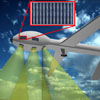Darpa’s Smart, Flat Camera Is Packed With Beady Eyes
Prof. Marc Christensen is developing camera technology that creates a high-res picture from many low-res sensors.

By David Hambling
Troops and unmanned aircraft could be the first to benefit from a new smart, ultra-slim camera technology which combines the images from many low-resolution sensors to create a high-resolution picture. Known as Panoptes, it promises lightweight, flat cameras with the power of a big lens in a device just five millimeters thick. It’s being developed by Marc Christensen, a professor at Southern Methodist University, with funding from Darpa. Planned applications include sensors for miniature drones and helmet-cams for soldiers.
A key feature of the system is that is made up of a large number of tiny imagers. These are small, simple cameras, each directed independently by a MEMS-controlled micro-mirror. Because there is no large lens, Pantoptes can be made flat, unlike other cameras.
A central processor combines the images into a single picture, producing a higher resolution than the individual imagers. The intelligence is in the way that the system identifies areas of interest and concentrates the sub-imagers on the relevant part of the scene. Christensen gives the example of the Panoptes system looking at a building in a field.
“After a first frame or two was collected, the system could identify that certain areas, like the open field, had nothing of interest, whereas other areas, like the license plate of a car parked outside or peering in the windows, had details that were not sufficiently resolved,” he tells (Wired's) Danger Room. “In the next frame, subimagers that had been interrogating the field would be steered to aid in the imaging of the license plate and windows, thereby extracting the additional information.”
As well as concentrating on areas of interest, the smart software will combine the overlapping images in a way that will give a clear image without the ‘noise’ associated with low-resolution imagers like camera phones. This sounds like it might require a tremendous amount of processing power. But it’s possible to achieve good frame rates — 30-60 per second — using a normal digital signal processor.
# # #